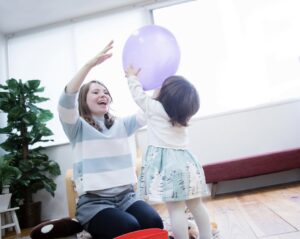Play, Creativity, and Attachment
Recently I had the opportunity to attend a two-day training in Theraplay, an evidence based treatment modality that involves the entire family. Theraplay has been shown to be extremely effective in treating issues such as complex trauma, grief, and attachment issues. What I find most appealing about Theraplay is how fun, creative, hands-on, and in a way simple it is. While it is a highly structured modality that is driven by the activities that a Theraplay certified practitioner specifically chooses for each client system, it looks like good old-fashioned play and what is more healing, fun, and awesome than play!
I believe that Theraplay truly exemplifies the concept that the power of healing lies in the trusting and stable therapeutic relationship that is built with the client. We really don’t need any bells and whistles for therapy to be a healing and freeing experience. Theraplay also uses the healing power of touch to build and grow the attachment between the parent and their child. In the aftermath of COVID, touch has become almost a dangerous thing but never before has there been more need for healing, loving, and playful touch and Theraplay provides that in abundance.

Theraplay has four treatment dimensions: 1) Structure, 2) Engagement, 3) Nurture, and 4) Challenge. Structure activities focus on the development of a healthy relationship with the presence of a caring adult who can make the child feel that they are in the hands of someone who can keep them safe and can guide them. The Engagement activities focus on the child in an intensive, personal way in order to make an attuned connection. The Nurture activities focus on the premise that the sensitive, contingent responses of a caring parent are an important factor in the development of secure attachment. Lastly, the Challenge dimension helps the child take mild, age appropriate risks that promote feelings of competence and confidence.
Being a parent is rewarding and challenging at the same time and sometimes we can feel overwhelmed and helpless because we cannot help our children the way that they need to be helped. With the active involvement and participation of parents in Theraplay and the guidance of the Theraplay therapist, parents and children begin the process of navigating emotional traumas they have experienced either together or in the case of foster children or adopted children have brought in with them into their new families.

Theraplay activities are a wonderful and congruent match with Child Centered Play Therapy as well. As a CCPT practitioner I have often incorporated Theraplay activities in family play therapy sessions with children and families I am privileged to work with. These activities set a structured yet playful tone to our session and it is delightful to see parents and children laughing and having fun while deepening their attachment to one another. Here are a few simple activities you can incorporate into your week and spend some wonderful quality time with your child: Blow up a balloon and toss it back and forth with one another, give our child a body massage while speaking to them in a soft and loving tone, have a cotton ball fight with one another, or put a blindfold on your child and then direct them from one side of the room to another by giving them very clear and explicit directions. Theraplay and Child Centered Play Therapy set a firm foundation for the more difficult aspects of family work with a light touch and a genuine belief that children and their families already possess the capacity for meaningful change within themselves. All that is needed is guidance and patience to get families to heal and move forward.
About the Author:
Kathy Precht, LCSW. Kathy is also trained in play therapy and working towards her Registered Play Therapy certification. She has over 20 years of experience working with children and adolescents ages 4-17 years old in different roles that she has held over the years in agencies and school settings. She has experience working with clients from diverse cultural and socioeconomic backgrounds and brings a culturally sensitive and inclusive lens to her therapy practice.

